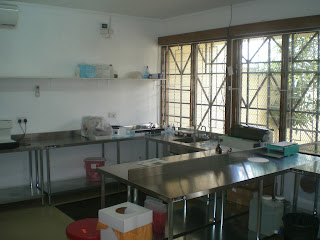Kevin Golden, MD/PhD
PGY-5, Surgical Pathology Fellow
The infrastructure for most of Malawi’s pathology is set in the country’s two largest and most populous cities: Blantyre and the capital, Lilongwe. They are separated by 366 kilometers of mud-soaked highway, speckled with farming villages and local markets along the entire route. This translates to about a four and half hour bus ride, which doesn’t seem like a long length of time to squeeze into the seat, unless that person (me) was six foot five. Nonetheless, outside of my leg falling asleep and the bus having to swerve around the occasional stray goat in the road, our journey was an uneventful one.
 |
| Pathology laboratory in Lilongwe |
The hospital in Lilongwe is set at the top of a hill overlooking part of the city. We, as pathologists, don’t have a large amount of daily exposure to patients, so our tour started and ended in the pathology laboratory. I entered the lab with similar expectations as to what I had seen while working for the last two weeks in the College of Medicine in Blantyre. I quickly found out that this was not the case, however, as this pathology lab looked something like out of a catalog: clean, shiny metal workbenches with all new automated equipment, imaging software attached to the computer, and, as spoiled as this sounds, air conditioning. (Although the open-air pathology sign out room in Blantyre has a nice cross breeze in the afternoons, there is something about a cool 73 degrees that allows one to have better focus on the task at hand.)
All of these factors seemed to improve the quality of the H&E stains on the slides, even to that which is comparable to what I see back in Boston.Unfortunately, the challenges of diagnosis remain the same. The specimens are usually accompanied by a limited clinical history and no available ancillary immunohistochemistry tests are available. There are also several similarities in the surgical samples, which include some of the largest and most destructive tumors I have seen in my short career as a pathologist. I’m not quite sure if the reason that patients wait to see a physician is more of a national infrastructure problem or a problem of access for care, but I digress.
 |
| Reviewing cases in Lilongwe |
We stayed in Lilongwe for two days, cutting in surgical specimens from the prior week, and diagnosing cases that had been submitted as long back as November. There are no full-time pathologists in Lilongwe, so cases are compiled together either to be read every couple of weeks by a visiting pathologist or sent down to Blantyre to be read by the full-time pathologists stationed there. Either way, the turn around time is a week or two at best. At its worst, it can be months.
Despite differing outside appearances for both locations, the problem remains the same: too many specimens and not enough staff. The entire country of 22 million people employs three residing full-time pathologists. These pathologists are responsible for signing out cases, as well as teaching and administrative duties. The logjam of cases can cause a delay in reporting results, thus causing a delay in crucial treatment. This is where I feel that my work as volunteer pathologist becomes most important. I hope that in my short time I can indeed make a difference, no matter in which city I am.

No comments:
Post a Comment